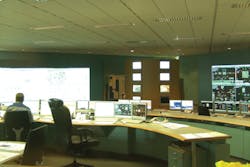Viewing PSIM through a lens of change
Editor’s Note: This is the second article in Dr. Bob Banerjee’s two-part series on how organizations can leverage PSIM to better manage growth and adapt to change. In his first article, Leveraging PSIM to address security growing pains, Banerjee discusses nine ways that PSIM solutions can help large, multi-site companies manage growth while maximizing their physical security.
If there is one truth in life, it’s that very little ever stays the same. Perpetual change is part and parcel of our human existence. Organizations, and the environments in which they thrive and exist, are dynamic as well. Change is at the center of the security universe. Over its lifetime, a command and control center may need to keep pace with all kinds of change: changing roles, changing information sources, changing processes and policies, changing people, changing technology, and so on.
1. Changing roles
Historically, the command and control center has had a rigid scope of responsibilities, mostly security related, while other entities in the organization have maintained responsibility for other types of incidents related to their own specific areas of operation. But this model of the security universe is beginning to shift. For example, departments and functions such as facilities, HVAC, and the network operations center (NOC) may be unrelated to the security command center. Increasingly, organizations are expanding the role and responsibility of the command center to handle incidents related to these and other areas. This approach is gaining prominence in those organizations that perceive the role of the command center not just as security, but rather, as central to ensuring that the overall organization functions flawlessly. A downside of this expanding mandate is that it puts an added burden on the command and control center to handle a greater variety and quantity of incidents with the same amount of resources. PSIM’s embedded, automated response plans can help in this regard. Using the PSIM solution, control center operators are guided by step-by-step procedures so they can efficiently and effectively handle any one of a number of security or operational situations.
Different agencies or departments may also maintain their individual responsibilities and roles, but use PSIM as a kind of glue to connect them, so they can collaborate more effectively. PSIM links different departments through a common situational awareness/situation management software platform, while still giving individual departments a perspective (on the incident) that is unique and relevant to them. For example, in an airport a maintenance issue could cause gate closures and impact checkpoints, so different groups would need to coordinate on a resolution. PSIM facilitates this coordination through instant mutual situational awareness, streamlined communication, and coordinated, automated response plans.
2. Changing information sources
Let’s say you’ve acquired a new technology that allows you to detect something better than before — a camera with smarter video analytics, a fence shake detector that’s less prone to error, a more intelligent software algorithm that detects fraudulent activity at a bank’s ATM. Now the only question is — how will you add this “new thing” to your existing security infrastructure? Will it be a siloed system with its own screen? It doesn’t have to be. Using PSIM, you can integrate it with your other sub-systems to feed your ever-improving situational awareness.
Then there’s the issue of version control for the different systems that make up your security infrastructure. Without PSIM, version control is critical. Any new security technology needs to be version compatible with everything else, and it can be a nightmare to keep everything in sync. But with PSIM, the new sub system only has to be version compatible with the PSIM software to work with everything else that’s tied into it. This is one of the reasons why organizations turn to PSIM to connect a VMS to an access control system, an intrusion system and a fire system, for example. Otherwise it’s just too easy for one wrong version to cause everything to collapse. And it’s not just about situational awareness. If you use a communication system such as mass notification, or add a new radio handset or a new GPS tracking system, integrating these systems together can be the key to better incident management.
3. Changing processes and policies
Policies and procedures change frequently in organizations. The security organization is no exception. When such changes occur, PSIM’s automated response plans ensure that security operators get up to speed on these new response plans quickly. PSIM also minimizes the need for operator re-training and addresses natural inconsistencies among operator skill levels by digitizing standard operating procedures into workflows to guide all operators to a consistent, compliant result. There’s no need to memorize policies and procedures or look them up in a binder. Once the operator has learned the mechanics of the PSIM solution, all he or she has to do is read, click and act.
4. Changing people
In an ideal world, staff in the command and control center, agents in the field, senior management and external stakeholders would never change. Everyone would remain in their positions and just continue to become more proficient. But that, of course, is a pipe dream. So how can we expect a novice command and control center operator to know exactly who to call and what to do, in a specific situation? Searching directories and asking around has now been replaced by technology.
All large organizations now have Lightweight Directory Access Protocol (LDAP) systems that maintain this type of directory information. By integrating it with PSIM, a digitized standard operating procedure can automatically inherit any and all changes in resource assignments by location. So if the next step in responding to an incident is to call the facilities manager for the east wing of a building 3,000 miles away, the novice operator (or any operator for that matter) doesn’t need to know who that is or how to reach them. PSIM makes the right call and the operator just picks up the phone. The value of this cannot be overemphasized, especially when there is a need to engage with external organizations, including regulatory bodies.
5. Changing technology
If you’ve ever made a significant investment in a given technology, you know it can feel like you’re tied to it at the hip. You can’t possibly make a move to a different technology or new vendor — even if you want to, right? Not so with PSIM – because PSIM offers a progressive migration strategy where the old can co-exist with the new and the operator won’t even notice the difference.
With PSIM, if the access control system tells an operator that a door has been left open and the operator wants to verify that with video, he can view the map showing the door location, then instantly click on the camera icons on either side of the door. It doesn’t matter if the two cameras are being recorded on the same VMS or different ones; or if one camera is a new megapixel camera being recorded on a modern NVR running sophisticated video analytics, while the other one is a 15 year-old analog camera being recorded on a 10 year-old DVR. Old and new can be seamlessly blended together.
The bottom line is “rip and replace” costs for significant investments are impractical. PSIM helps eliminate these costs by offering a migration path that enables organizations to adopt new technology, while continuing to leverage their past investments.
About the Author: Dr. Bob Banerjee is senior director of training and development for NICE Systems’ security division. He can be reached at [email protected].





